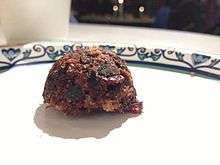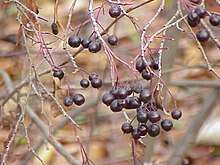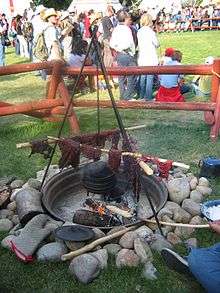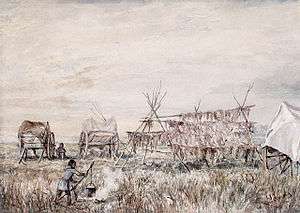Pemmican
Pemmican is a mixture of tallow, dried meat and dried berries used as a nutritious food. Historically, it was an important part of indigenous cuisine in certain parts of North America, and is still prepared today.[1][2] The word comes from the Cree word pimîhkân, which itself is derived from the word pimî, "fat, grease".[3] The Lakota (or Sioux) word is wasná, originally meaning "grease derived from marrow bones", with the wa- creating a noun, and sná referring to small pieces that adhere to something.[4][5] It was invented by the Indigenous peoples of North America.[6][7]

.jpg)
Pemmican was widely adopted as a high-energy food by Europeans involved in the fur trade and later by Arctic and Antarctic explorers, such as Captain Robert Bartlett, Ernest Shackleton, Richard E. Byrd, Fridtjof Nansen, Robert Falcon Scott, George W. DeLong and Roald Amundsen.
Ingredients

Traditionally, the specific ingredients used for pemmican were usually whatever was available. The dried meat is often in the form of large game meat such as bison, deer, elk, or moose, but the use of fish such as salmon, and smaller game such as duck, is not uncommon.[8][9] The meats used in contemporary pemmican may also include beef. Dried fruit, such as cranberries and Saskatoon berries, are sometimes added. Blueberries, cherries, chokeberries, and currants are also used, but in some regions, these fruits are almost exclusively in ceremonial and wedding pemmican.[10] The additional use of sugar was noted in the journals of European fur traders.[8] These ingredients are mixed together with rendered animal fat (tallow).
Among the Lakota and Dakota nations, there is also a corn wasná (or pemmican) which does not contain dried meat. This is made from toasted cornmeal, animal fat, fruit, and sugar. [11]
Traditional preparation

Traditionally, pemmican is prepared from the lean meat of large game such as bison, elk, deer, or moose. The meat is cut in thin slices and dried, either over a slow fire or in the hot sun until it was hard and brittle. (About 5 pounds (2,300 g) of meat are required to make 1 pound (450 g) of dried meat suitable for pemmican.) This thin brittle meat is known in Cree as Pânsâwân and colloquially in North American English as "dry meat".[12] The Pânsâwân was then spread across tanned animal hide pinned to the ground, where it is beaten with flails or ground between two large stones till it turned into very small pieces, almost powder-like in its consistency.[8] The pounded meat is mixed with melted fat in an approximate 1:1 ratio by volume.[13] Typically the melted fat would be suet that has been rendered into tallow.[14] In some cases, dried fruits, such as blueberries, chokecherries, cranberries, or Saskatoon berries, were pounded into powder and then added to the meat/fat mixture. The resulting mixture is then packed into rawhide bags for storage where it would cool, and then harden into pemmican.[8] Today, some people store their pemmican in glass jars or tin boxes. Since there is no "official" recipe for pemmican, the shelf life can vary depending on ingredients and storage conditions. At room temperature, pemmican can generally last from one to five years,[15] but there are anecdotal stories of pemmican stored in cool cellars being safely consumed after a decade or more. If vacuum sealed (e.g., in an MRE), it can still be edible after more than a century.[16]
A bag of bison pemmican weighing about 90 lb (41 kg) was called a taureau (French for "bull") by the Métis of Red River. These bags of taureaux (lit. "bulls"), when mixed with fat from the udder, were known as taureaux fins, when mixed with bone marrow, as taureaux grand, and when mixed with berries, as taureaux à grains.[17] It generally took the meat of one bison to fill a taureau.[18]
Serving
In his notes of 1874, North-West Mounted Police Sergeant-Major Sam Steele records three ways of serving pemmican: raw; boiled in a stew called "rubaboo"; or fried, known in the West as a "rechaud":
The pemmican was cooked in two ways in the west; one a stew of pemmican, water, flour and, if they could be secured, wild onions or preserved potatoes. This was called "rubaboo"; the other was called by the plains hunters a "rechaud". It was cooked in a frying pan with onions and potatoes or alone. Some persons ate pemmican raw, but I must say I never had a taste for it that way.[19]
History
The voyageurs of the Canadian fur trade had no time to live off the land during the short season when the lakes and rivers were free of ice. They had to carry their food with them if the distance traveled was too great to be resupplied along the way.[20] A north canoe (canot du nord) with six men and 25 standard 90-pound (41 kg) packs required about four packs of food per 500 miles (800 km). Montreal-based canoemen could be supplied by sea or with locally grown food. Their main food was dried peas or beans, sea biscuit, and salt pork. (Western canoemen called their Montreal-based fellows mangeurs de lard or "pork-eaters".) In the Great Lakes, some maize and wild rice could be obtained locally. By the time trade reached the Winnipeg area, the pemmican trade was developed.[20]

Métis would go southwest onto the prairie in Red River carts, slaughter bison, convert it into pemmican, and carry it north to trade at the North West Company posts. For these people on the edge of the prairie, the pemmican trade was as important a source of trade goods as was the beaver trade for the Indians farther north. This trade was a major factor in the emergence of a distinct Métis society. Packs of pemmican would be shipped north and stored at the major fur posts: Fort Alexander, Cumberland House, Île-à-la-Crosse, Fort Garry, Norway House, and Edmonton House. So important was pemmican that, in 1814, governor Miles Macdonell started the Pemmican War with the Métis when he passed the short-lived Pemmican Proclamation, which forbade the export of pemmican from the Red River Colony.[21]
Alexander Mackenzie relied on pemmican on his 1793 expedition across Canada to the Pacific.[22]
North Pole explorer Robert Peary used pemmican on all three of his expeditions, from 1886 to 1909, for both his men and his dogs. In his 1917 book Secrets of Polar Travel, he devoted several pages to the food, stating, "Too much cannot be said of the importance of pemmican to a polar expedition. It is an absolute sine qua non. Without it a sledge-party cannot compact its supplies within a limit of weight to make a serious polar journey successful."[23]
British polar expeditions fed a type of pemmican to their dogs as "sledging rations". Called "Bovril pemmican" or simply "dog pemmican", it was a beef product consisting, by volume, of 2⁄3 protein and 1⁄3 fat (i.e., a 2:1 ratio of protein to fat), without carbohydrate. It was later ascertained that although the dogs survived on it, this was not a nutritious and healthy diet for them, being too high in protein.[24] Members of Ernest Shackleton's 1914–1916 expedition to the Antarctic resorted to eating dog pemmican when they were stranded on ice for the winter.[25]

During the Second Boer War (1899–1902), British troops were given an iron ration made of four ounces of pemmican and four ounces of chocolate and sugar. The pemmican would keep in perfect condition for decades.[26] It was considered much superior to biltong, a form of cured game meats commonly used in Africa. This iron ration was prepared in two small tins (soldered together) which were fastened inside the soldiers' belts. It was the last ration used and it was used only as a last resort—when ordered by the commanding officer. A man could march on this for 36 hours before he began to drop from hunger.[27]
American adventurer Frederick Russell Burnham, while serving as Chief of Scouts for the British Army in South Africa, required pemmican to be carried by every scout.[28]
A 1945 scientific study of pemmican criticized using it exclusively as a survival food because of the low levels of certain vitamins.[29]
A study was later done by the US military In January 1969 called Arctic Survival Rations, III. The Evaluation of Pemmican Under Winter Field Conditions.[30] The study found that during a cycle of two starvation periods the subjects could stave off starvation for the first cycle of testing with only 1000 calories worth of pemmican.[30] During the second study they found that not only did the subjects survive the period but recorded a significant decrease in psychological disturbances.[30]
In 2019, a successfully preserved pemmican and grain mixture from a 1906 US Army Emergency Ration Pack was eaten by Youtuber Steve Thomas. The filmed footage was then released the following year on 7 March 2020.[31]
Contemporary uses
People in many indigenous communities across North America today continue to make pemmican for personal, community, and ceremonial consumption. Some contemporary pemmican recipes incorporate ingredients that have been introduced to the Americas in the past 500 years, including beef. There are also indigenous-owned companies, such as Tanka Bar, based on Pine Ridge Indian Reservation in South Dakota, that produce pemmican or foods based on traditional pemmican recipes, for commercial distribution.
See also
- Kanemochi, also called "butter mochi" (バター餅), a similarly nutritious substance used by Matagi hunters in northern Japan
- Agutak
- Food drying
- Forcemeat
- Jerky
- Mincemeat
- Smoked fish
- Smoked meat
- Tolkusha
References
- Posted by info@lakotarednations.com on November 30, 2017 (2017-11-30). "Wo Lakota Making Wasna". Lakota Red Nations. Retrieved 2018-09-17.
- "NANF". www.tankabar.com.
- Sinclair, J.M. (ed) English Dictionary Harper Collins: 2001.
- "Native Recipes". sacred.indigenous.youth.education.circle.mysite.com.
- "New Lakota Dictionary Online". www.lakotadictionary.org. Retrieved 2020-02-12.
- McLagan, Jennifer (2008). Fat: An Appreciation of a Misunderstood Ingredient. p. 195. ISBN 978-1580089357.
- Morton, Mark (2004). Cupboard Love: A Dictionary of Culinary Curiosities. Insomniac Press. p. 222. ISBN 1894663667.
- Merriam, Willis B. (1955). "The Role of Pemmican in the Canadian Northwest Fur Trade". Yearbook of the Association of Pacific Coast Geographers. 17 (1): 34–38. doi:10.1353/pcg.1955.0000. ISSN 1551-3211.
- Sherman, Sean (2017). The Sioux Chef's Indigenous Kitchen. Minneapolis, MN: University of Minnesota Press. ISBN 978-0816699797.
- Albala, Kevn (2011). Food Cultures of the World Encyclopedia. p. 235. ISBN 9780313376269.
- Goodwin, Janice. "Healthy Traditions: Recipes of our Ancestors" (PDF). National Center for Native American Aging at the Center for Rural Health, University of North Dakota School of Medicine & Health Sciences. Retrieved 2020-02-12.
- Gladue, Ian. "Interviewed with owner of Pânsâwân Dry Meat". CBC Radio. Radio Active. Retrieved January 29, 2019.
- Angier, Bradford How to Stay Alive in the Woods (originally published as Living off the Country 1956) ISBN 978-1-57912-221-8 Black Dog & Levanthal Publishers, Inc. Page 107
- "Pemmican Recipes". Alderleaf Wilderness College. Retrieved 23 February 2019.
- https://ultimateprepping.com/how-long-does-pemmican-last/
- 1906 US Army Emergency Ration Preserved Survival Food Testing 24 Hour MRE Review https://www.youtube.com/watch?v=562nQKR3_3M
- "Pemmican by Lawrence J. Barkwell". Retrieved 2013-01-24.
- Joseph James Hargrave (1871), Red River (page 168) (Red river. ed.), Montreal: Printed for the author by J. Lovell, OCLC 5035707
- Myrna Kostash; Duane Burton (2005). Reading the River: A Traveller's Companion to the North Saskatchewan River. Coteau Books. p. 160. ISBN 978-1-55050-317-3.
- Carolyn Podruchny (2006). Making the Voyageur World: Travelers and Traders in the North American Fur Trade. U of Nebraska Press. p. 118. ISBN 0-8032-8790-9.
- Hayes, Derek (2006). Historical Atlas of Canada. p. 178. ISBN 9781553650775.
- Stefansson, Vilhjalmur (2005). Great Adventures and Explorations: From the Earliest Times to the Present As Told by the Explorers Themselves. p. 328. ISBN 1417990902.
- Peary, Robert E. (1917). Secrets of Polar Travel. Century Company. pp. 77–83.
- Taylor, R. J. F. "The physiology of sledge dogs" Archived 2003-11-29 at the Wayback Machine, Polar Record 8 (55): 317–321 (January 1957), reprinted in The Fan Hitch, Volume 5, Number 2 (March 2003)
- Alfred Lansing, Endurance, (New York: McGraw Hill, 1969) Library of Congress Catalog Card Number: 58-59666
- Stefansson, Vilhjalmur (1946). Not by Bread Alone. New York: MacMillan Company. pp. 211, 270. OCLC 989807.
- Stefansson, Vilhjalmur (1946). Not by Bread Alone. New York: MacMillan Company. pp. 263–264, 270. OCLC 989807.
- Burnham, Frederick Russell (1926). Scouting on Two Continents. New York: Doubleday, Page & Company. OCLC 407686.
- "Defects of Pemmican as an Emergency Ration for Infantry Troops". Nutrition Reviews. 3 (10): 314–315. 1 October 1945. doi:10.1111/j.1753-4887.1945.tb08500.x. Retrieved 2018-01-04.
- "PEMMICAN". Nutrition Reviews. 19 (3): 73–75. 2009-04-27. doi:10.1111/j.1753-4887.1961.tb01895.x.
- 1906 US Army Emergency Ration Preserved Survival Food Testing 24 Hour MRE Review, retrieved 2020-03-09